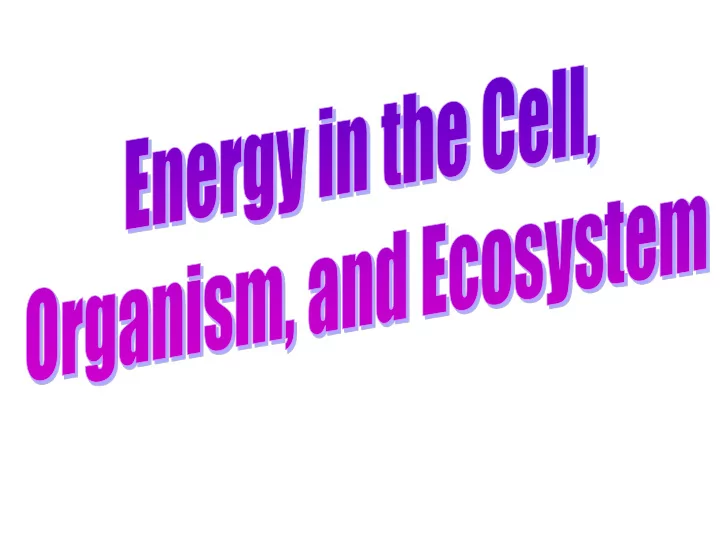

Energy in the Cell ATP= Most commonly used energy in the cell Adenosine triphosphate - Adenosine with 3 phosphate molecules attached Origins of ATP Mitochondria convert food energy (i.e. carbohydrates) to ATP A working muscle cell spends and recycles up to 10 million ATP molecules per second
ATP & Energy Energy is required to hold ATP molecules together – phosphate molecules are polar and are trying to repel one another When ATP bonds are broken, energy is released ATP energy is used for metabolism and all other bodily processes Benefits of ATP • Cell does not need to store excess energy • As long as have phosphate, have unlimited energy • Energy is renewable in this case • In a pinch, ADP can be used for energy
aka Cellular Respiration
Introduction: Muscles are attached to bones. As your muscles contract they move the bones to which they are attached. This in turn allows your body to move and do work. Working your muscles requires energy. This energy is the result of cellular respiration and may lead to the build- up of lactic acid, which in turn causes fatigue. The muscles that open and close your hand are located in your forearm. The number of times you can open and close your hand indicates the amount of work these muscles can do
Procedure: Trial # Ability to Do Work 1.Prepare a data table similar to the 1 one shown. 2 2.Rest your elbow on the table. Open 3 and close your hand rapidly and 4 forcefully, counting the number of 5 times you can do this in 30 seconds. 6 Record your results in the space 7 provided. 8 3.Rest for 10 seconds. During this 9 time, record your results. 10 4.Repeat steps 2 and 3 nine more 5 Minute Rest times. Record each of your results in 11 the space provided. 12 5.Rest for five (5) minutes. Repeat Steps 2 and 3 two more times and record your results.
Analysis and Conclusion Questions 1. How did your results change over time? 2. What effect did repeating the exercise over time have on the muscle group? 3. As you repeated the exercise over time, how did your muscles feel? 4. What physiological factors are responsible for fatigue? 5. How well do you think your fatigued muscles would work after 30 minutes of rest? 6. Apply this concept to some other type of muscular work you do every day. Examples include tapping your foot to keep beat in band, lifting weights for football, or running for soccer.
General Overview Glucose (C 6 H 12 O 6 ) is a product of photosynthesis Sunlight 6 CO 2 + 6 H 2 O C 6 H 12 O 6 + 6O 2 Chlorophyll Glucose is a basic food for all living things Glucose contains so much energy, the cell would die if all the energy were released at one time
General Overview Cellular respiration is the release of this energy a little bit at a time 6 CO 2 + 6 H 2 O C 6 H 12 O 6 + 6O 2 Energy
Glycolysis Glucose Breaking of the glucose Glycolosis Occurs in the cytoplasm Converts the 6-carbon sugar into two 3-carbon compounds called pyruvates Anaerobic respiration (no oxygen) Produces 2 energy molecules
Glucose Glycolosis Aerobic Occurs in the mitochondria Kreb Cycle Produces lots of Energy Requires oxygen Electron Transport Chain
Glucose Glycolosis Anaerobic No oxygen required Organisms in low O 2 environments Organisms low on O 2 Fermentation Produces small amounts of energy Lactic Acid Alcohol
Glucose Glycolosis Anaerobic Aerobic Fermentation Kreb Cycle Lactic Acid Electron Transport Alcohol Chain
aka Comparing Photosynthesis and Cellular Respiration
Comparing Photosynthesis and Cellular Respiration Comparison of Photosynthesis and Cellular Respiration Complementary Photosynthesis Cellular Respiration processes Chloroplast/Cytoplasm Mitochondria Food accumulated Food broken down Both reactions Energy from light Energy from chemical bonds must occur for organisms to Stores energy Releases energy have usable Reactants: CO 2 , H 2 O Reactants: Glucose and O 2 energy Products: Glucose, O 2 Products: CO 2 , H 2 O Only in presence of light Occurs day and night Requires chlorophyll Occurs in all living cells
Recommend
More recommend